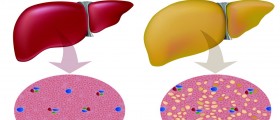
Causes
There are many reasons for cirrhosis to occur. Alcoholism, chronic hepatitis, autoimmune hepatitis, bile duct disorders or nonalcoholic fatty liver disease (NAFLD) and others can cause this disease.
Alcoholism
Chronic alcoholism causes alcoholic liver disease which includes alcoholic hepatitis (chronic liver inflammation induced by heavy drinking), fatty liver (process of building up fat cells in patient's liver), and alcoholic cirrhosis. Alcoholic cirrhosis is the main type of cirrhosis in western world. More than 10% of heavy drinkers will develop this type of cirrhosis after 10-50 years of drinking. Alcohol is being transformed into toxins by a liver, causing an inflammation of liver tissue.
Chronic hepatitis
Whether it is type B or type C, hepatitis is another primary reason for developing cirrhosis. Type B is prevalent type of hepatitis in less developed countries, while hepatitis C is common cause of cirrhosis in developed countries like US. People, who suffer hepatitis B and hepatitis D simultaneously, are at the greatest risk of developing cirrhosis. Hepatitis virus is causing cirrhosis by destroying liver cells which would, eventually, form a layer of necrotic tissue around the liver. Hepatitis C is often caused by sharing needles while taking drugs.
Autoimmune hepatitis
As other autoimmune disorders, autoimmune hepatitis is caused by a misguided immune system of a patient. The immune system recognizes liver cells as foreign objects and attacks them. This type of hepatitis often goes with some other autoimmune disease.
Bile ducts disorders
Bile duct disorder can cause cirrhosis when the tissue blocks the bile flow through bile ducts, which causes building the bile up in the liver afterward, causing the inflammation. Primary billiard cirrhosis and primary sclerosing chlorangitis are the syndromes related to bile duct disorders.
Nonalcoholic Fatty Liver Disease (NAFLD)
Obesity and type 2 diabetes are the main reasons for one to develop NAFLD. Other reason for developing this disorder is excessive fats intake. Some recent studies revealed that insulin resistance is the main factor for developing NAFLD in type 2 diabetes patients. This disorder can lead to Nonalcoholic Steatohepatitis (NASH). It is slow process that can lead to cirrhosis or even cancer.
Nonalcoholic Steatohepatitis (NASH)
NASH is characterized by liver inflammation, fatty liver or liver injury. It occurs in about half of people who suffer diabetes and three quarters of obese people.
Hereditary disorders
Hemochromatosis is a disorder caused by bad iron processing in ones liver. Organs of the people with this type of disorder absorb too much iron from food, which is impossible for liver to process.
Alpha-1 antitrypsin deficiency, Wilson’s disease and glycogen storage diseases are other hereditary disorders.
Other causes for liver cirrhosis are schistosomiasis and long-term disposal to high levels of some chemicals.

















Your thoughts on this
Loading...